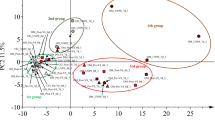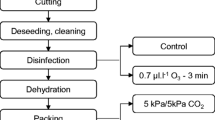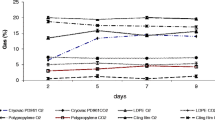Abstract
This study evaluated the effects of gas composition in kimchi packaging on kimchi quality. Completely sealed packaging without gas inflow/outflow during fermentation (S1), packaging allowing gas outflow (S2), and packaging allowing gas inflow and outflow (S3) were used. Microbial composition analysis, volatile compound content analysis, and sensory evaluation were performed to determine the differences in kimchi quality among samples. Metabolites were examined using principal component analysis. Gas composition analysis showed that the ratio of CO2 increased during the storage period in S1, the ratio of nitrogen and CO2 contents was constant in S2, and the ratio of oxygen was significantly higher in S3. No significant differences in the lactic acid bacteria number were observed. However, coliforms were only detected in S3, and yeast and mold proliferated faster in S3 than in S2 or S1. The main compounds detected in S1 and S2 were alcohols, whereas those in S3 were esters such as β-phenethyl acetate produced by yeast. Sensory evaluation showed that S3 had the lowest odor, taste, and overall scores, whereas S2 had the highest. In conclusion, the gas composition inside the kimchi package greatly affects the quality of kimchi. Our findings provide important data that can be useful in the manufacture of commercial kimchi.





Similar content being viewed by others

Abbreviations
- PE:
-
Polyethylene
- LAB:
-
Lactic acid bacteria
- PCA:
-
Plate count agar
- YM:
-
Yeast mold
- OTUs:
-
Operational taxonomic units
- BSTFA:
-
N, O-bis-(trimethylsilyl)-trifluoroacetamide
- TMCS:
-
Trimethylchlorosilane
- SPME:
-
Solid-phase microextraction
- PDMS:
-
Polydimethylsiloxane
References
Choi YJ, Yong S, Lee MJ, Park SJ, Yun YR, Park SH, Lee MA (2019) Changes in volatile and non-volatile compounds of model kimchi through fermentation by lactic acid bacteria. LWT-Food Sci Technol 105:118–126
Hung LD, Kyung KH (2006) Inhibition of yeast film formation in fermented vegetables by materials derived from garlic using cucumber pickle fermentation as a model system. Food Sci Biotechnol 15:469–473
Jeong SY, Yoo SR (2016) Kimchi packaging technology: an overview. Korean J Packag Sci Technol 22:41–47
Jeong JW, Kim OS, Sung JM (2011) Quality and fermentation characteristics of kimchi made with different types of dried red pepper (Capsicum annum L.). Prev Nutr Food Sci 16:74–82
Jeong SH, Lee SH, Jung JY, Choi EJ, Jeon CO (2013) Microbial succession and metabolite changes during long-term storage of kimchi. J Food Sci 78:M763–M769
Jeong SY, Cho CH, Lee HG, Lee JS, Yoo SR (2018) Development and application of multi-function valve to solve major problems of expansion and off-odor leakage in the packaging of kimchi. Korean J Packag Sci Tech 24:113–120
Jeong SY, Lee HG, Lee JS, Yoo SR (2019) Critical review on active technologies to regulate the levels of carbon dioxide and oxygen for kimchi packaging. J Korean Soc Food Cult 34:233–239
Jung JY, Lee SH, Kim JM, Park MS, Bae JW, Hahn Y, Madsen EL, Jeon CO (2011) Metagenomic analysis of kimchi, a traditional Korean fermented food. Appl Environ Microbiol 77:2264–2274
Jung EH, Ryu JP, Lee SI (2012) A study on foreigner preferences and sensory characteristics of kimchi fermented for different periods. J Korean Soc Food Culture 27:346–353
Jung J, Lee K, Puligundla P, Ko S (2013) Chitosan-based carbon dioxide indicator to communicate the onset of kimchi ripening. LWT-Food Sci Technol 54:101–106
Kim MJ, Lee HW, Lee ME, Roh SW, Kim TW (2019) Mixed starter of Lactococcus lactis and Leuconostoc citreum for extending kimchi shelf-life. J Microbiol 57:479–484
Kim MJ, Lee HW, Kim JY, Kang SE, Roh SW, Hong SW, Kim TW (2020) Impact of fermentation conditions on the diversity of white colony-forming yeast and analysis of metabolite changes by white colony-forming yeast in kimchi. Food Res Int 136:109315
Lee JY, Kim CJ, Kunz B (2006) Identification of lactic acid bacteria isolated from kimchi and studies on their suitability for application as starter culture in the production of fermented sausages. Meat Sci 72:437–445
Lee HJ, Lee MJ, Choi YJ, Park SJ, Lee MA, Min SG, Park SH, Seo HY, Yun YR (2021) Free amino acid and volatile compound profiles of jeotgal alternatives and its application to kimchi. Foods 10:423
Lei L, Xiao S, Yang Q, Yalin L, Yufei T, Zhenming C, Guorong L, Rao Yu (2019) Effect of different fermenting containers on the deterioration of Sichuan pickle. LWT-Food Sci Technol 111:829–836
Moon SH, Chang MI, Kim HY, Chang HC (2014) Pichia kudriavzevii is the major yeast involved in film-formation, off-odor production, and texture-softening in over-ripened Kimchi. Food Sci Biotechnol 23:489–497
Park SE, Seo SH, Kim EJ, Byun S, Na CS, Son HS (2019) Changes of microbial community and metabolite in kimchi inoculated with different microbial community starters. Food Chem 274:558–565
Shin DH, Cheigh HS, Lee DS (2002) The use of Na2CO3-based CO2 absorbent systems to alleviate pressure buildup and volume expansion of kimchi packages. J Food Eng 53:229–235
Trindade de Carvalho B, Holt S, Souffriau B, Lopes Brandao R, Foulquie-Moreno MR, Thevelein JM (2017) Identification of novel alleles conferring superior production of rose flavor phenylethyl acetate using polygenic analysis in yeast. Mbio 8:e01173-e1217
Wang X, Ren X, Shao Q, Peng X, Zou W, Sun Z, Zhang L, Li H (2020) Transformation of microbial negative correlations into positive correlations by Saccharomyces cerevisiae inoculation during pomegranate wine fermentation. Appl Environ Microbiol 86:e01847-e1920
Yun YR, Lee JJ, Lee HJ, Choi YJ, Lee JH, Park SJ, Park SH, Seo HY, Min SG (2021) Comparison of quality characteristics of commercial Kimchi manufactured in Korea, China, and the United States. Foods 10:2488
Acknowledgements
This work was supported by the R&BD support program (KM2104)—funded by Inno-package Co., Ltd.—and the WIKIM Research Program (KE2203-1) through the World Institute of Kimchi, funded by the Ministry of Science, ICT, and Future Planning, Republic of Korea.
Funding
The Project is funded by Inno-package Co., Ltd. (Award no.: KM2104, Grant recipient: Sung Gi Min) and World Institute of Kimchi (Award no.: KE2203-1, Grant recipient: Sung Gi Min).
Author information
Authors and Affiliations
Contributions
HJY performed the data collection and wrote, SHP and EHK, and YJC helped with the data collection and manuscript editing, SG Min conceived the idea, supervised the work and edited the manuscript.
Corresponding author
Ethics declarations
Conflict of interest
The authors declare that they have no competing interests.
Consent to participate
All authors of the manuscript are aware from submission of this manuscript.
Consent for publication
This manuscript has not been published or presented elsewhere in part or in entirety. All study participants provided informed consent, and the study design was approved by the appropriate ethics review board. We have read and understood your journal’s policies, and we believe that neither the manuscript nor the study violates any of these.
Additional information
Publisher's Note
Springer Nature remains neutral with regard to jurisdictional claims in published maps and institutional affiliations.
Supplementary Information
Below is the link to the electronic supplementary material.
Rights and permissions
Springer Nature or its licensor (e.g. a society or other partner) holds exclusive rights to this article under a publishing agreement with the author(s) or other rightsholder(s); author self-archiving of the accepted manuscript version of this article is solely governed by the terms of such publishing agreement and applicable law.
About this article
Cite this article
Yu, H.J., Park, S.H., Kim, E.H. et al. Effect of headspace gas composition in kimchi packaging on the quality characteristics of kimchi. J Food Sci Technol 60, 2695–2703 (2023). https://doi.org/10.1007/s13197-023-05795-z
Revised:
Accepted:
Published:
Issue Date:
DOI: https://doi.org/10.1007/s13197-023-05795-z



